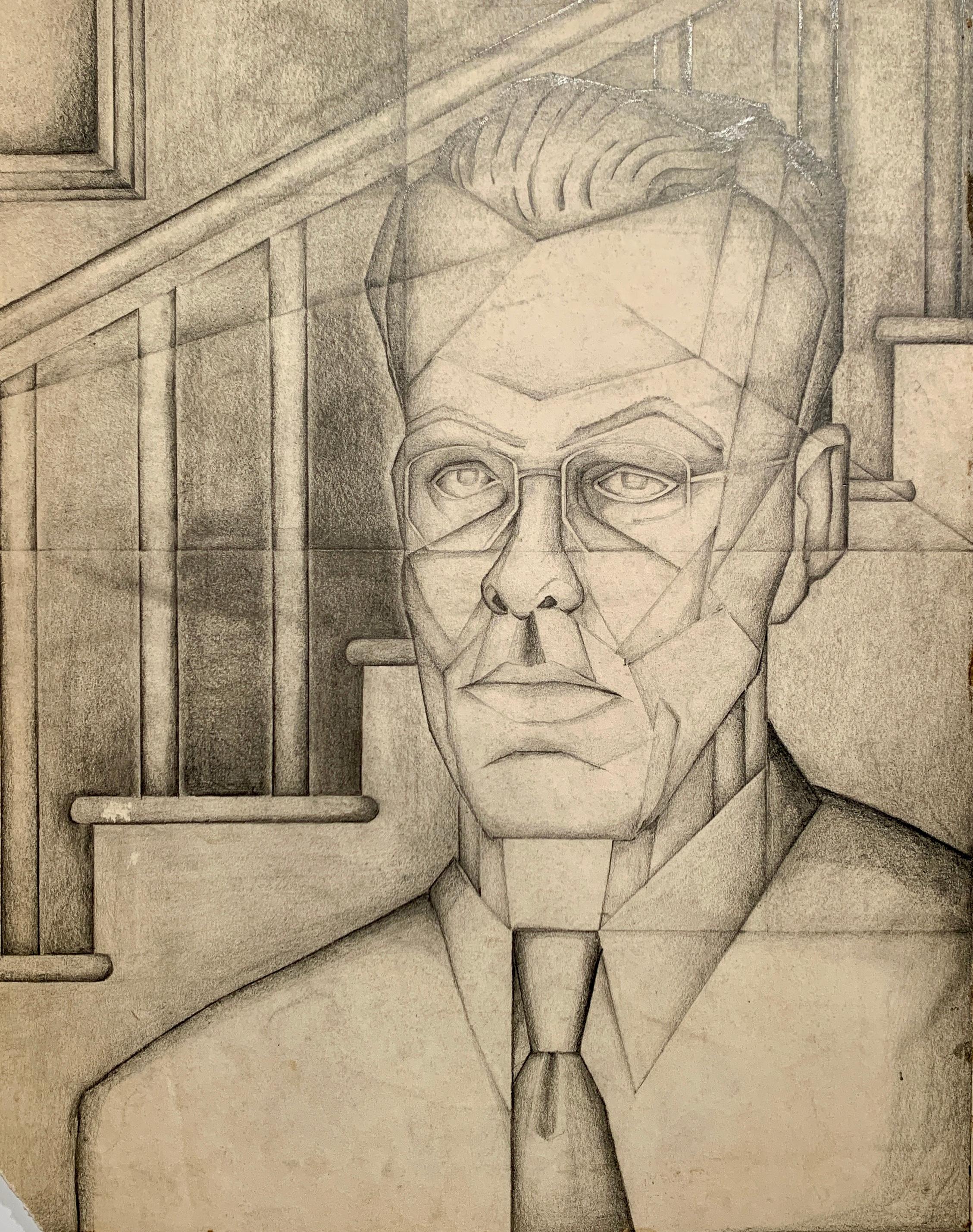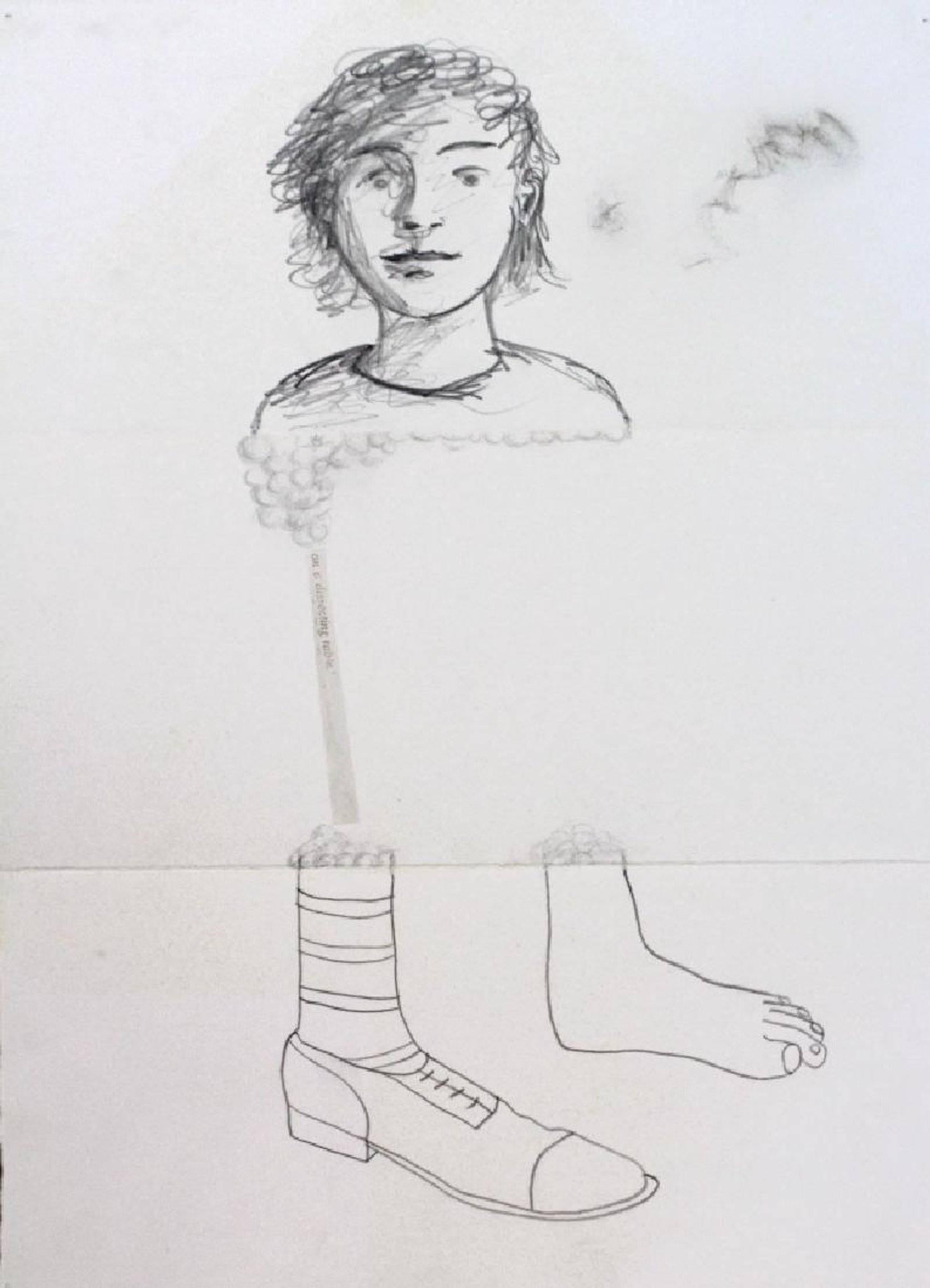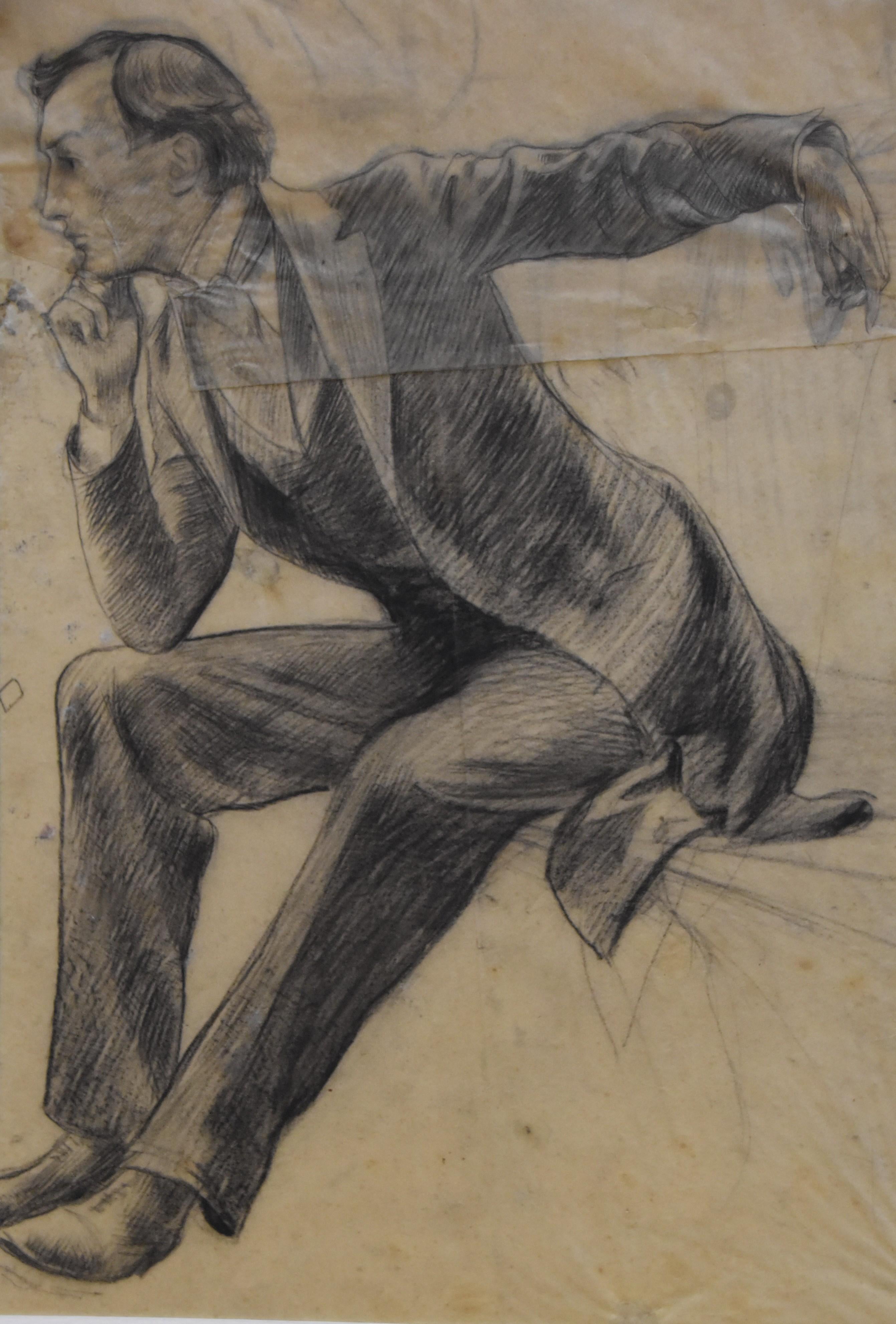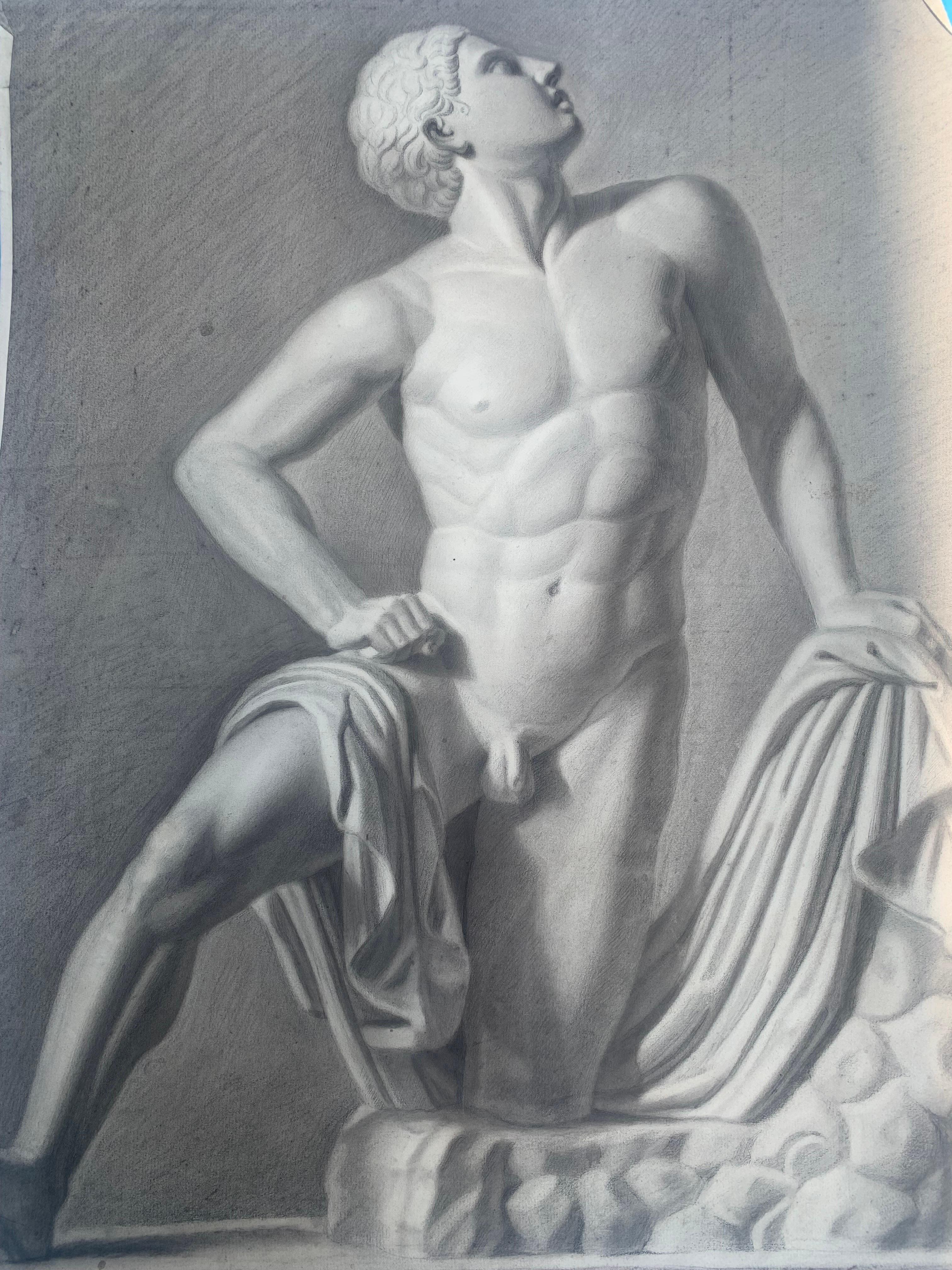Items Similar to Still Life with Vera as Raphael Original Drawing
Want more images or videos?
Request additional images or videos from the seller
1 of 10
Josef LeviStill Life with Vera as Raphael Original Drawing1991
1991
About the Item
In this delicate drawing, artist Josef Levi takes reference to art history by combining figures within one composition. The two characters depicted in this composition utilize the bottom half of the great artist Raphael, gradually phasing into the portrait of lovely lady named Vera.
Josef Alan Levi (1938) is an American artist whose works range over a number of different styles, but which are unified by certain themes consistently present among them. Levi began his artistic career in the 1960s and early '70s, producing highly abstract and very modernist pieces: these employing exotic materials such as light fixtures and metallic parts. By 1975, Levi had transitioned to painting and drawing still lifes. At first these were, traditionally, of mundane subjects. Later, he would depict images from art history, including figures originally created by the Old Masters. Around 1980, he made another important shift, this time toward creating highly precise, though subtly altered reproductions of pairs of female faces which were originally produced by other artists. It is perhaps this work for which he is most well known. Since around 2000, Josef Levi has changed the style of his work yet again: now he works entirely with computers, using digital techniques to abstract greatly from art history, and also from other sources.
Levi's works of art in the collections of the Museum of Modern Art, NYC, the National Gallery of Art, and the Albright-Knox Museum, among many others. Levi's art has been featured on the cover of Harper's Magazine twice, once in June 1987, and once in May 1997.
Josef Levi received a Bachelor of Arts degree in 1959 from the University of Connecticut, where he majored in fine arts and minored in literature. From 1959 to 1960, he served to a first lieutenant in the U.S. Army, and from 1960 through 1967 he was in the U.S. Army Reserves.
In 1966, he received the Purchase Award from the University of Illinois in 1966, and he was featured in New Talent U.S.A. by Art in America. He was an artist in residence at Appalachian State University in 1969, taught at Farleigh Dickenson University in 1971 and was a visiting professor of art at Pennsylvania State University in 1977. From 1975 to 2007, Levi resided in New York City. He now lives in an apartment in Rome, where he is able to paint with natural light as he was unable in New York.
From 1959 to 1960, Josef took some courses of Howard McParlin Davis and Meyer Schapiro at Columbia University which initiated him into the techniques of reproducing the works of the Old Masters. His first works, created in the 1960s, were wood and stone sculptures of women. His first mature works were abstract pieces, constructed of electric lights and steel.
In 1970, Levi's materials included fluorescent light bulbs, Rust-Oleum and perforated metal in addition to paint and canvas.
By 1980, Josef Levi's art had transformed into a very specific form: a combination of reproductions of female faces which were originally depicted by other artists. The faces which he reproduces may be derived from either portraits or from small portions of much larger works; they are taken from paintings of the Old Masters, Japanese ukiyo-e, and 20th-century art. Artists from whom he has borrowed include: Vermeer, Rembrandt, Piero della Francesca, Botero, Matisse, Utamaro, Correggio, Da Vinci, Picasso, Chuck Close, Max Beckmann, Pisanello, Lichtenstein. The creation of these works is informed by Levi's knowledge and study of art history.
Josef Levi's paintings from this period are drawn, then painted on fine linen canvas on wooden stretchers. The canvas is coated with twenty-five layers of gesso in order to produce a smooth surface on which to work. The drawing phase takes at least one month. Levi seals the drawing with acrylic varnish, and then he may apply layers of transparent acrylic in order to approximate the look of old paintings. After the last paint is applied, another layer of acrylic varnish is sprayed on to protect the work.
Most of the figures in his contemporary pieces are not paired with any others.
SELECTED COLLECTIONS
MUSEUM OF MODERN ART, NEW YORK, NY
ALBRIGHT- KNOX GALLERY, BUFFALO, NY
ALDRICH MUSEUM OF CONTEMPORARY ART, RIDGEFIELD, CT
NATIONAL GALLERY OF ART, WASHINGTON, DC
BROOKLYN MUSEUM OF ART, BROOKLYN, NY
SMITHSONIAN NATIONAL MUSEUM OF AMERICAN HISTORY, WASHINGTON, DC
CORCORAN GALLERY, WASHINGTON, DC
UNIVERSITY OF NOTRE DAME ART GALLERY, NOTRE DAME, IN
ARKANSAS ART CENTER, LITTLE ROCK, AR
HOOD MUSEUM OF ART, DARTMOUTH COLLEGE, HANOVER, NH
BANK OF NEW YORK, NEW YORK, NY
CHRYSLER CORPORATION, DETROIT, MI
EXXON CORPORATION, NEW YORK, NY
AT&T CORPORATION, NEW YORK, NY
BOWDOIN COLLEGE MUSEUM OF ART, BRUNSWICK, ME
NEW BRITAIN MUSEUM OF AMERICAN ART, NEW BRITAIN, CN
STORM KING ART CENTER, MOUNTAINVILLE, NY
YALE UNIVERSITY ART MUSEUM, NEW HAVEN, CT
- Creator:Josef Levi (1938, American)
- Creation Year:1991
- Dimensions:Height: 27 in (68.58 cm)Width: 21 in (53.34 cm)
- Medium:
- Movement & Style:
- Period:
- Condition:minor foxing, waviness to paper. light wear to frame. no Glass.
- Gallery Location:Surfside, FL
- Reference Number:1stDibs: LU38212539292
Josef Levi
Josef Alan Levi (1938 – Present) Josef Alan Levi is an American artist, his works in the 1960s and early ‘70s were highly abstract and very modernist. He transitioned to painting and drawing still lifes. Mainly his work consisted of traditional, mundane subjects, then depicting images from art history, even including pieces originally created by the Old Masters. Levi has since shifted to creating highly precise, with subtly altered reproductions by other artists. This work is what is he most known for. The important themes seen throughout Levis work are the female form and the similarities in visual aesthetics. His works can be seen at the Museum of Modern Art, National Gallery of Art, among many others.
About the Seller
4.9
Platinum Seller
These expertly vetted sellers are 1stDibs' most experienced sellers and are rated highest by our customers.
Established in 1995
1stDibs seller since 2014
1,560 sales on 1stDibs
Typical response time: 1 hour
- ShippingRetrieving quote...Ships From: Surfside, FL
- Return PolicyA return for this item may be initiated within 3 days of delivery.
More From This SellerView All
- Exquisite Corpse, Cadavre Exquis, Spanish Surrealist Drawing 3 ArtistsBy Xisco MensuaLocated in Surfside, FLProvenance: This piece was deaccessioned from the Bass museum in Miami Beach florida. This piece is a good museum example of Exquisite corpse, also known as exquisite cadaver (from the original French term cadavre exquis), A method by which a collection of words or images is collectively assembled. This example is by Manuel Saez, Xisco Mensua and Guillermo Paneque. Each collaborator adds to a composition in sequence, either by following a rule or by being allowed to see only the end of what the previous person contributed. The technique was invented by surrealists. Surrealism principal founder André Breton reported that it started in fun, but became playful and eventually enriching. In the beginning were Yves Tanguy, Marcel Duchamp, Jacques Prévert, Benjamin Péret, Pierre Reverdy, and André Breton. Other participants probably included Max Morise, Joan Miró, Man Ray, Simone Collinet, Tristan Tzara, Georges Hugnet, René Char, and Paul and Nusch Éluard. Henry Miller often partook of the game to pass time in French cafés during the 1930s. Manuel Sáez (born 6 March 1961) is a Spanish, self-taught artist. Since 1984, he has been living and working in Valencia. The Enciclopedia Universal Ilustrada Europeo-Americana describes Manuel Sáez as among the most important painters of the turn of the 21st century owing to his simultaneously sensual and psychological approach to the world of objects, landscapes, figures and portraits. As a resident fellow of the Spanish Fine Arts Academy in Rome in 1990, Sáez elaborated a series of portraits called Biografia no autorizada In 1991 Sáez held his first important show at the Fundació La Caixa. in Valencia In 1996 he presented his first retrospective, Colección Exclusiva 1984-1995, in the Club Diario Levante of Valencia, as well as the Madrid Circle of Fine Arts, the Salas Verónicas of Murcia, the Castellón Delegation and the Brocense of Cáceres. In 2000 Sáez exhibited in Mexico City's Museo Rufino Tamayo and in the Instituto Valenciano de Arte Moderno (IVAM) in Valencia. In 2008 Sáez's work could be seen at the Sala Parpalló in Valencia. In 2003-04, Dispersions was exhibited at the Bass Museum of Art in Miami. In 2007, Sáez's work is featured in the Valencian Institute of Modern Art's (IVAM) El Pop Art en la Colección del IVAM ("Pop Art in the IVAM Collection") in Valencia.[12] Xisco Mensua Initially studied at Escuelas Virtèlia, but followed an atypical school career due to illness. Began to paint in 1978. Took a course in painting at the Escola d’Arts i Oficis (Valencia), where he had lived since the age of eight. Lived in Barcelona from 1982 to 1987, studying art at the Escola Eina for the first two years. Returned to Valencia and began exhibiting in 1990. Produced works in co-operation with Fernando Ros and Mim Juncà, as well as designing stage sets for the theatre. Now forms part of the Jacques Moran collective. Through drawing, Mensua creates a fictional world in an exercise in which he transfigures common references, whether intimate or biographic, political or social. Guillermo Paneque Seville, 1963 Spanish painter. He completed his artistic training at the Faculty of Fine Arts in Seville, Director and founder, along with Rafael Agredano and José Espaliú, of the magazine Figura in 1984. It is in the mid-eighties when his work is made known within the Andalusian artistic scene, through the production of small format paintings populated with references and symbols from the religious and everyday environment that the author mixes with a playful sense and with erotic characters that reveal a clear rejection of the Andalusian artistic tradition. His work evolves towards a formal synthesis and an iconographic cleansing in the line of conceptual art. He has starred in numerous solo exhibitions and participated in important collectives, among which include: Aperto 86 at the Venice Biennial (1986), Spain 87. Dynamiques and Interrogations (1987) at the Musée d'Art Moderne de la Ville in Paris, Spanish natures...Category
20th Century Surrealist Figurative Drawings and Watercolors
MaterialsPaper, Charcoal, Carbon Pencil
- Original Pencil Drawing from PIERRE, "I DONT CARE" (CBS 1970s)By Maurice SendakLocated in Surfside, FLAn original animation drawing from the CBS-TV broadcast of Sendak's "REALLY ROSIE" - (this was the first time "Rosie" appeared anywhere other than Sendak's original book) - this cel is from the PIERRE, "I DONT CARE" sequence. this is the original pencil drawing from the 1970s. it is from the estate of the film producer Dan Hunn. Maurice Bernard Sendak, June 10, 1928-2012 Dubbed by one critic “the Picasso of children’s literature” and once addressed by former President Bill Clinton as “the King of Dreams,” Maurice Sendak illustrated nearly a hundred picture books throughout a career that spanned more than 60 years. Some of his best known books include Chicken Soup...Category
1970s Pop Art Figurative Drawings and Watercolors
MaterialsCarbon Pencil, Paper
- Original Pencil Drawing from PIERRE, "I DONT CARE" (CBS 1970s)By Maurice SendakLocated in Surfside, FLAn original animation drawing from the CBS-TV broadcast of Sendak's "REALLY ROSIE" - (this was the first time "Rosie" appeared anywhere other than Sendak's original book) - this cel is from the PIERRE, "I DONT CARE" sequence. this is the original pencil drawing from the 1970s. it is from the estate of the film producer Dan Hunn. Maurice Bernard Sendak, June 10, 1928-2012 Dubbed by one critic “the Picasso of children’s literature” and once addressed by former President Bill Clinton as “the King of Dreams,” Maurice Sendak illustrated nearly a hundred picture books throughout a career that spanned more than 60 years. Some of his best known books include Chicken Soup...Category
1970s Pop Art Figurative Drawings and Watercolors
MaterialsPaper, Carbon Pencil
- Old Jewish Shtetl Rabbi Charcoal Judaica Drawing World War II EraBy Maurycy TrebaczLocated in Surfside, FLMaurycy Trębacz (1861 – 1941) was one of the most popular Jewish painters in Poland in the late 19th and early 20th century. Many of his paintings were lost in the Holocaust, but a representative selection of his artwork survived.Trębacz died of starvation in the Litzmannstadt Ghetto during the Nazi German occupation of Poland. Maurycy Trębacz, along with Samuel Hirszenberg, Jakub Weinles, and Leopold Pilichowski, belonged to the first generation of Jewish artists in Poland who broke away from the religious prohibition on portraying a human figure (see below). The studies show his mastery of painting, his own unique style and great imagination. Trębacz was noted within the European art-world as a master portrait and landscape painter,[1] but above all he was also a rare chronicler of the contemporary Jewish life, depicting a world that is now lost. His popular subjects included praying Rabbis, old men, street and Jewish domestic scenes, and genre painting depicting the everyday side of life. His psychological portraits of Jews earned him the greatest popularity and critical acclaim, and influenced the work of other Jewish painters in Poland. Notably, Trębacz's oil painting "The Good Samaritan", reportedly stolen in 1904 at the World's Fair, was recently sold at auction at Sotheby's. Born in 1861 in Warsaw, the son of David Trębacz, a house painter, Maurycy (Mojżesz) at the age of 16 years was admitted to the school of drawing by professor Wojciech Gerson and Aleksander Kamiński. Three years later, with the support of Leopold Horowitz, he received a scholarship sponsored by lawyer Stanisław Rotwand, and moved to Kraków where he enrolled in the Academy of Fine Arts in the studios of Jan Matejko, Leopold Loeffler and Władysław Łuszczkiewicz. From 1882, he studied at the Academy of Fine Arts in Munich with Sandor Wagner (until 1884) and received the grand silver medal there at the completion of his studies for the work "Martyrdom". Between 1889 and 1890, he studied in Paris at the Académie Colarossi. He lived and worked in Munich for 4 years before returning to Warsaw. Over time, Trębacz worked in Lviv and Drohobych, and eventually moved permanently to Łódź, where he founded and ran a private art school until September 1939. He is often criticized for giving in to popular demand later on in his career. Pressured by financial sponsors, he began to produce sentimental theme portraits pertaining to the bucolic life of country folk. Trębacz made his successful artistic début twice, first at the Munich Kunstverein, and then at the Krywult Salon in Warsaw as a 23-year-old painter. His another big success was the participation of painting "Good Samaritan" (1886, pictured) in a Kunstverein exhibition in Munich as well as at the I National Art Exhibition in Kraków and in Warsaw at the Zachęta Society for the Promotion of Fine Arts. The painting was also awarded a gold medal at the Universal World Exposition in Chicago. Subsequently, Trębacz also received a bronze medal at the Paris Universal World Exposition of 1889. "Good Samaritan" (1886), book engraving from painting by Maurycy Trębacz, Warsaw Maurycy Trębacz died of hunger in the Łódź Ghetto...Category
1930s Expressionist Figurative Drawings and Watercolors
MaterialsPaper, Charcoal, Graphite
- RARE WPA ARTIST ISAAC FRIEDLANDER Judaica Drawing 1946By Isaac FriedlanderLocated in Surfside, FLArtist: Friedlander, Isaac American (1890-1968) Isac Friedlander Latvian-born American Printmaker, 1890-1968 was born in Mitau, Latvia. He studie...Category
20th Century American Realist Figurative Drawings and Watercolors
MaterialsCharcoal, Pencil
- Donna Librea, Mixed Media Wall Hanging DrawingBy Alex BeardLocated in Surfside, FLAmerican painter and author Alex Beard is best known for his elaborate wildlife compositions created in his signature style of gesturalpainting, which he has coined “Abstract Naturalism.” Raised in a family that fostered philanthropy, creativity and exploration, Alex has traveled extensively around the world. The diverse cultures, colors, and climates of Africa, India, China, the Americas, and Australia have profoundly influenced both his professional and artistic practice. While earning his BA from Tufts University, he studied painting and drawing at the School of the Museum of Fine Arts in Boston. In his early twenties Alex moved to New Orleans to continue his formal training at the New Orleans Academy of Fine Arts. Fueled by curiosity about the cultures and wildlife he had been exposed to in his early years, Alex has spent much of his life traveling to the some of the world’s most remote wildlife outposts - paintbrush in hand. His time in nature enables him to continually hone his style – creating complex compositions in which abstraction and figuration collide, while exploring themes of cultural and environmental interconnectivity. Alex’s work figures prominently in several private and public collections and he has exhibited extensively throughout the United States, including solo exhibitions in New York, Los Angeles, New Orleans, and abroad in Hong Kong. An impassioned conservationist and philanthropist, in 2012 Alex established The Watering Hole Foundation – a public charity engaged in saving endangered wildlife and preserving their environments. His documentary, Drawing the Line, fused his artistic talent with his dedication to preservation, chronicling the plight of the endangered Wild African Elephant, as seen through the eyes of a conservationist artist. In addition to producing a series of short films, Alex has authored and illustrated a critically acclaimed trilogy of storybooks published by Abrams. The series, Tales from the Watering Hole, includes The Jungle Grapevine (2008), Monkey See Monkey Draw (2009), and Crocodile Tears (2010). Along with other New Orleans artists Raine Bedsole, Dr. Bob, George Dunbar, Mitchell Gaudet, Alan Gerson, Thomas Mann, Steve Martin, James Michalopoulos...Category
1990s Contemporary Mixed Media
MaterialsPaper, Charcoal, Mixed Media
You May Also Like
- 1940s Charcoal and Pencil Portrait of a ManLocated in Arp, TXArtist Unknown "Tie and Glasses" c. 1940s Charcoal and pencil on paper 13.5"x17" image 15.5"x19" paper unframed $250 Unsigned *Listed price reflects custom framing selected by seller...Category
1940s Modern Portrait Drawings and Watercolors
MaterialsPaper, Charcoal, Carbon Pencil
- Self Portrait (original signed drawing)By John HelikerLocated in New York, NYJohn Heliker Self Portrait, 1991 Charcoal Pencil on Paper (with original Kraushaar Galleries label verso) Signed on the front bears the original KRAUSHAAR GALLERIES label on the verso on the frame Vintage metal frame included Self portrait done in charcoal pencil by distinguished American artist John Heliker. Hand signed on the front This work is framed - bears the label of the renowned KRAUSHAAR GALLERIES on the verso. Image size: 13 inches by 10 inches; Framed: 18 1/2 inches by 14 1/2 inches About John Heliker from The New York Times Obituary, 2000 (Roberta Smith) John Heliker, a painter and teacher who was a fixture of the New York art world for nearly seven decades, died on Tuesday at the Sonojee Estate, a health center in Bar Harbor, Me. He was 91 and had lived in New York during most of his career, spending summers on Cranberry Island...Category
Late 20th Century Modern Portrait Drawings and Watercolors
MaterialsCharcoal, Carbon Pencil, Paper
- G A Rochegrosse (1859-1938) Study for the Exposition Internationale Paris 1900By Georges Antoine RochegrosseLocated in Paris, FRGeorges Antoine Rochegrosse (1859-1938) A man sitted, Study for the decoration of the Salle des fêtes (Ballroom) of the Exposition Internationale, Paris 1900 Pencil and charcoal on thin yellow paper 29.5 x 20 cm In acceptable condition : Tears and creases as visible on the photographs. In a modern frame : 46 x 36.5 cm Annotations on the back of the mount (now under the modern frame) that identifiy this drawing as a preparatory study for the decoration of the Salle des fêtes (Ballroom) of the 1900 Paris Exposition Internationale. It's also indicated that Henri Bataille...Category
1890s Symbolist Portrait Drawings and Watercolors
MaterialsCharcoal, Carbon Pencil
- Untitled (Sideview of a Gentleman)By John GilroyLocated in New York, NYJohn Thomas Young Gilroy (English, 1898-1985), "Untitled: Sideview of a Gentleman", Charcoal/Pencil on Paper signed and matted to original card stock, 20.75 x 12.75 (22 x 14), Early 20th Century, 1920 Colors: White, Black John Thomas Young Gilroy (30 May 1898 – 11 April 1985) was an English artist and illustrator, best known for his advertising posters for Guinness, the Irish stout. He signed many of his works, simply, "Gilroy". Born in Whitley Bay, Northumberland, England, Gilroy attended Durham University until his studies were interrupted by World War I, during which he served with the Royal Field Artillery. He resumed studying at the Royal College of Art in London, where he remained as a teacher. He taught at Camberwell College of Arts.[1] In 1925, he gained employment at S.H. Benson's advertising agency, where he created the iconic advertisement art for Guinness featuring the Zoo Keeper and animals enjoying Guinness.[2] He worked with Dorothy L. Sayers.[3] He was also an accomplished portrait painter, numbering Royalty, Politicians, Actors and many others amongst his sitters. He worked in his large studio at 10 Holland Park, London, the former home and studio of Sir Bernard Partridge. He was a long-standing and much loved member of the Garrick Club...Category
1920s Academic Portrait Drawings and Watercolors
MaterialsCharcoal, Carbon Pencil
- A son of Niobe. Italian Academic drawing. XIX century.Located in Firenze, ITA son of Niobe. Italian Academic drawing. XIX century. Charcoal drawing on paper. Dimensions: cm 58 x cm 43. Good conservation conditions with small defects on margins. This dra...Category
19th Century Academic Nude Drawings and Watercolors
MaterialsPaper, Charcoal, Carbon Pencil
- This Ain't Sotheby's This is Texas, Rosemary Mahoney, Cattle Auctions,Located in Houston, TX"People, the human figure, fascinate me. Regardless of age or social status, I take particular interest in grasping the one moment that belongs solely to an individual." - Rosemary Mahoney...Category
1990s American Impressionist Figurative Drawings and Watercolors
MaterialsCarbon Pencil, Charcoal
Recently Viewed
View AllMore Ways To Browse
Retro Drawing Style
Original Large Drawing
Japan Drawing
Drawings Brooklyn
Old Vintage Drawing
Old Vintage Drawings
Picasso Original Drawing
Nyc Drawing
Picasso Numbered Drawings
Japanese Original Drawing
Matisse Original Drawing
Vintage Face Drawing
Knox Gallery
Fine Vintage Linens
Buffalo Drawing
Fluorescent Light
Vintage Wooden Pencil
Vintage Wooden Pencils






